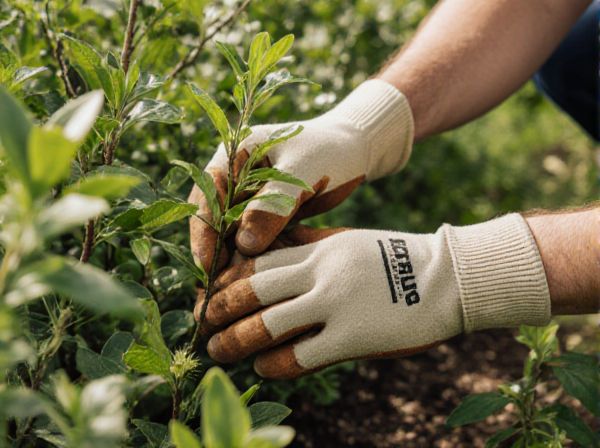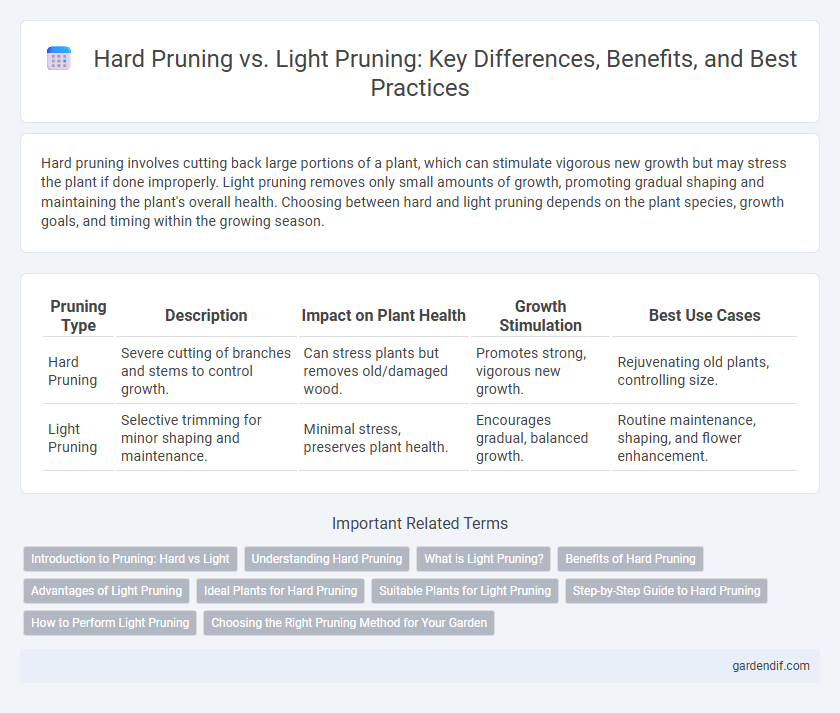
Hard pruning vs Light pruning Illustration
Hard pruning involves cutting back large portions of a plant, which can stimulate vigorous new growth but may stress the plant if done improperly. Light pruning removes only small amounts of growth, promoting gradual shaping and maintaining the plant's overall health. Choosing between hard and light pruning depends on the plant species, growth goals, and timing within the growing season.
Table of Comparison
| Pruning Type | Description | Impact on Plant Health | Growth Stimulation | Best Use Cases |
|---|---|---|---|---|
| Hard Pruning | Severe cutting of branches and stems to control growth. | Can stress plants but removes old/damaged wood. | Promotes strong, vigorous new growth. | Rejuvenating old plants, controlling size. |
| Light Pruning | Selective trimming for minor shaping and maintenance. | Minimal stress, preserves plant health. | Encourages gradual, balanced growth. | Routine maintenance, shaping, and flower enhancement. |
Introduction to Pruning: Hard vs Light
Hard pruning involves the removal of large branches or stems to reshape plants aggressively, which promotes robust growth and improved air circulation. Light pruning targets only small shoots or damaged parts, encouraging gradual growth and maintaining natural plant form. Understanding the balance between hard and light pruning techniques is essential for optimizing plant health and productivity.
Understanding Hard Pruning
Hard pruning removes entire branches or shoots, significantly impacting the plant's structure and growth potential by cutting back to main stems. This method encourages vigorous new growth and can improve air circulation and sunlight penetration, reducing disease risk. However, excessive hard pruning may stress the plant, delaying recovery and fruit production.
What is Light Pruning?
Light pruning involves selectively removing only a small portion of a plant's branches or stems, aiming to enhance growth without drastically altering the plant's shape or size. This technique promotes better air circulation and sunlight penetration, which supports healthier development and reduces the risk of disease. By maintaining most of the plant's structure, light pruning ensures continued vigor while encouraging natural growth patterns.
Benefits of Hard Pruning
Hard pruning enhances model efficiency by aggressively removing less important parameters, resulting in significant reduction of model size and faster inference times. This technique improves deployment feasibility on resource-constrained devices without substantially sacrificing accuracy. The streamlined architecture also facilitates easier model maintenance and potential for better generalization on unseen data.
Advantages of Light Pruning
Light pruning promotes healthier plant growth by preserving more foliage, which enhances photosynthesis and energy production. It reduces stress on the plant, leading to faster recovery and increased resistance to diseases and pests. This method supports sustained fruiting or flowering, improving overall yield quality and quantity.
Ideal Plants for Hard Pruning
Hard pruning is ideal for woody plants such as roses, hydrangeas, and fruit trees that can withstand significant cutting back to promote vigorous new growth. These plants typically enter a dormant phase during pruning, allowing for the removal of old, diseased, or dead wood without causing stress. Light pruning suits delicate shrubs and evergreens that require minimal shaping or thinning to maintain health and appearance.
Suitable Plants for Light Pruning
Light pruning is ideal for delicate or fast-growing plants such as herbs, young shrubs, and flowering perennials because it encourages healthy growth without causing stress. Plants like lavender, rosemary, and hydrangeas respond well to light pruning, which helps maintain shape and promotes blooming. This method removes minimal foliage, preserving the plant's natural structure while enhancing air circulation and light penetration.
Step-by-Step Guide to Hard Pruning
Hard pruning involves aggressively cutting back branches to promote vigorous growth and structural strength, typically removing 25-50% of the plant's canopy in a single session. Start by identifying and removing dead, diseased, or crossing branches, then proceed to cut major growth points to reshape the plant and encourage new shoots. Proper timing in late winter or early spring before active growth begins maximizes recovery and ensures healthy regrowth after hard pruning.
How to Perform Light Pruning
Light pruning involves selectively removing only dead, diseased, or crossing branches to maintain plant health and structure while minimizing stress. Use clean, sharp pruning tools to make precise cuts just above outward-facing buds or branches, encouraging healthy growth and airflow. This method preserves most foliage, enhancing photosynthesis and reducing vulnerability to pests and diseases.
Choosing the Right Pruning Method for Your Garden
Choosing the right pruning method depends on the plant species, growth stage, and garden goals. Hard pruning, which involves cutting back major branches, is ideal for rejuvenating overgrown shrubs and promoting vigorous new growth. Light pruning maintains the plant's shape and encourages steady blooming without stressing the plant, making it suitable for delicate or flowering species.
Hard pruning vs Light pruning Infographic

 gardendif.com
gardendif.com